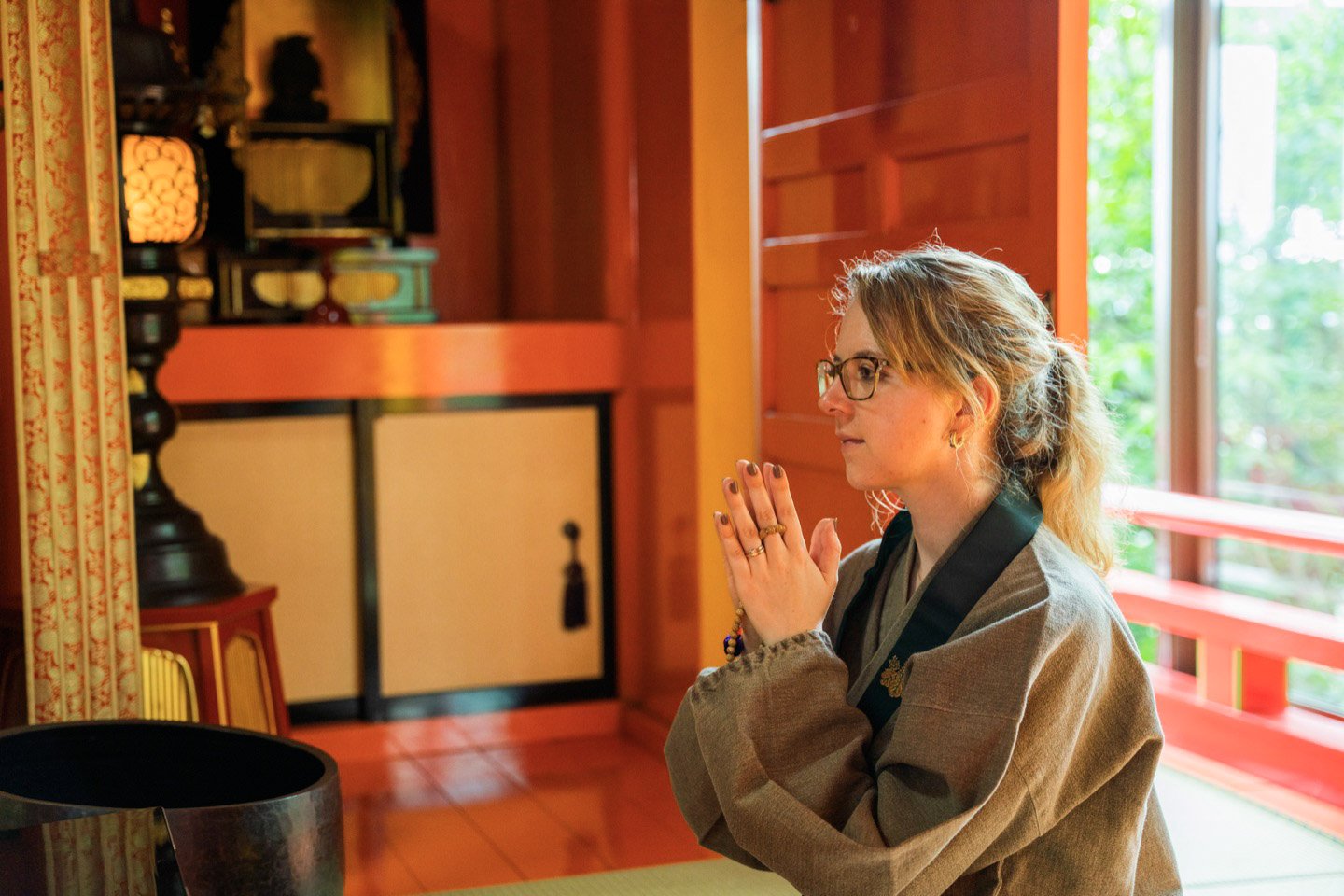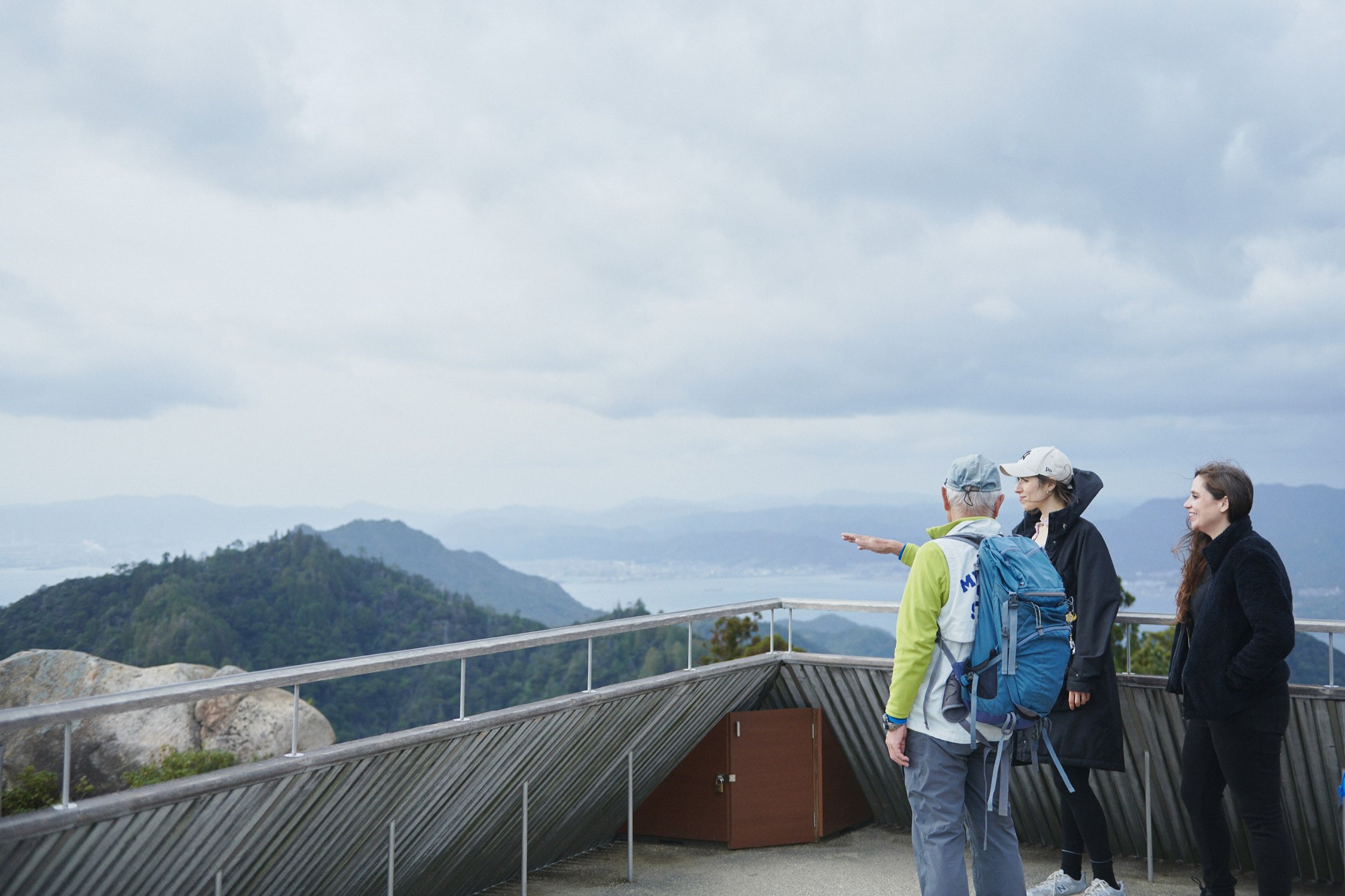Acquiring Magic Powers in Mountain Seclusion: Shugendo and Japanese Religion
By Nikolas Broy
Depicted as residences of deities, ghosts, and all kinds of supernatural agents detached from society, the image of mountains plays a significant role in traditional Japanese religion and culture. Far more than praising them for their soothing natural environments and picturesque views, nearly all religious traditions in Japan consider mountains to be sources of unmatched, numinous powers. Entering a mountain or living there permanently as a hermit means getting closer to one’s objects of veneration and spiritual inspiration.
In the eyes of most Japanese people, the religious tradition most commonly associated with seclusion in the mountains is Shugendo (修験道). Translated as “the Way to achieve miraculous powers through practice,” Shugendo is believed to help followers attain special abilities through the enduring of hardships during a period of mountain solitude. Through both a physical and mental practice, it is said that the most accomplished shugenja (修験者) (practitioners of Shugendo) are able to fly, walk on swords, become invisible, and enter boiling water. An ascetic tradition informed by many belief systems, Shugendo persists even today, its connection with secluded mountain peaks offering a respite far away from the demands of everyday life.
Influences on Shugendo
Even though many regard it as a perennial tradition that represents the very soul of Japanese culture, Shugendo emerged as a relatively unified system of beliefs only in the fifteenth century. Drawing on earlier practices of hermits, itinerant priests, and mountain recluses, Shugendo was enriched by various religions throughout its history, imported both from South and East Asia and indigenous to the Japanese archipelago.
In traditional Buddhist cosmology, for instance, the magnificent, mythological Mt. Meru is considered the center of the cosmos, where Buddhas, bodhisattvas (enlightened beings), and divine protectors reside. The historical Buddha Siddharta Gautama (ca. 5th–4th century BCE) is said to have taught the Lotus Sutra–a pillar text of East Asian Buddhism–on “Vulture Peak” in the northeastern mountains of India. In Chinese Buddhism, which arrived in Japan in the middle of the first millennium CE, the conception that particular Buddhas and bodhisattvas share an affinity with mountains became interwoven with indigenous beliefs in the spiritual power of the Chinese marchmounts.
Most notably, Japan’s own esoteric Buddhist strands of the Tendai (天台宗) and Shingon Schools (真言宗) can be seen as influences on Shugendo. Further scrutiny reveals many other religious elements as well, including Daoist dietary rules, terminology, and spells, but also indigenous Japanese beliefs in all kinds of deities and spirits. In fact, because of Shugendo’s amalgamation of various religious elements, which was seen as a threat to a state-crafted national identity, the Meiji government (1868–1912) prohibited the practice in 1872—a ban lifted only after imperial Japan’s surrender at the end of WWII.
Shugendo Practice
Although the technical term for Shugendo practitioners is shugenja, to the general public, they are commonly referred to as yamabushi (山伏). Literally meaning those who “crouch in the mountains,” this term was widely used to refer to mountain hermits before the advent of Shugendo in the fifteenth century. Traditional imagery portrays the mountain ascetics as recluses withdrawing from cultural achievements, including food, shelter, and clothing, while premodern Japanese sources depict them as wearing humble garments of moss, strengthening the shugenja’s association with the hermit. Today, shugenja wear a specific outfit that, while immersed in Buddhist cosmology and symbolism, is distinct from that of Buddhist monastics, particularly that of the tiny tokin black hats( 頭襟) and large conch shells known as hora (法螺), which are used as ritual instruments and to signal other groups nearby.
Traditionally, a shugenja aims to “realize Buddhahood within one’s physical body,” known in Japanese as sokushin jobutsu (即身成仏). This crucial concept shared by many Japanese Buddhist schools posits that it is possible to attain enlightenment within one life span, whereas earlier Buddhist traditions claim that this process requires myriads of existences. That is why during initiation, which involves wandering a mountain and practicing various rituals, the participants symbolically experience death and rebirth as physical Buddhas. Due to their austerities and practices, they gain all kinds of superhuman features and powers—hence the term shugen (修験), meaning to cultivate special, “magico-spiritual” powers. To achieve spiritual accomplishments, shugenja employ various means, both physical and linguistic.
PHYSICAL
On the path to sokushin jobutsu, practitioners employ various physical rituals in order to detach themselves from the mundane world of the human realm. While in the mountains, many recluses and short-term lay practitioners minimize their water and food intake, bathe in ice-cold water, and engage in hard physical labor, such as maintaining trails and weeding rice fields. Many practitioners also stop eating grains to purify themselves and ward off hazardous demons that purportedly reside inside human bodies, especially before and during rituals. This concept draws explicitly on Chinese Daoism, according to which these evil beings feed on grains.
One way to avoid grain-based foods is to partake exclusively of food collected in the mountains, such as pine needles, bark, chestnuts, seeds, and various grassroots. This practice, known as mokujiki (木食), is reminiscent of French anthropologist Claude Lévi-Strauss’ postulated dichotomy between “the raw” and “the cooked” as the defining features of the natural world and human culture, respectively. Hence, shugenjas’ rejection of cooked and otherwise processed food further signals their withdrawal from human society.
In the early 1960s, eight mummies were discovered in Shugendo temples in Yamagata Prefecture in the western Tohoku region of Honshu. Objects of veneration for some practitioners, these mummies exemplified how certain premodern shugenja interpreted sokushin jobutsu in a highly literal sense, attempting to physically achieve Buddhahood through self-mummification. Much of the folklore surrounding this practice is of questionable historicity, and such extreme forms of asceticism were generally restricted to only a minute sect of practitioners called Yudono (湯殿).
What is clear, however, is that by constantly challenging hunger, fatigue, pain, and all kinds of ordinary affections, shugenja seek to transcend their conventional selves through physical means.
LINGUISTIC
Beyond the physical body, shugenja believe that minds can be transformed through mudras (hand signs), mantras (short formulas), and meditation; in addition, Shugendo rituals also involve reciting more extended formulas (dharani) and entire texts, most notably the Heart Sutra, one of the most widely revered Buddhist texts in East Asia.
One such example is the saito goma (柴燈護摩), literally “firewood lamp votive ritual.” Based on the ancient Vedic fire sacrifice homa, it consists of votive offering logs stacked into a square. Filled with combustibles and covered with green boughs, the large bonfires produce enormous billows of smoke. Usually, the ritual burning is accompanied by the beating of drums and monotonous chanting of the Heart Sutra. Together, the hypnotic soundscape and the homa’s bright flames against the night sky create an awe-inspiring atmosphere. As the fires go out, practitioners may also walk over the embers to cleanse their karmic debts and, thus, brighten their futures.
Another essential ritual is the “cutting of the nine characters” (kuji kiri 九字切り), an esoteric teaching employed to ward off evil influences that originated in fourth-century Chinese Daoist scripture. Consisting of nine mudras and nine words that the practitioner combines synchronically, the sentence reads “rin-byō-tō-sha-kai-jin-retsu-zai-zen (臨兵鬭者皆陣列在前)” and translates as “Come down, soldiers and fighters, and line up before me.” This kuji kiri spell is also extremely popular in esoteric Buddhist traditions, and some readers may be familiar with it from its depictions in the popular anime series Sailor Moon.
In the pursuit of sokushin jobutsu, these physical and linguistic practices of Shugendo become inextricably linked, each necessary for the awakening of magico-spiritual powers. Ultimately, these rituals aid in a shugenja’s recognition of the concept of non-duality, a belief shared with Buddhism and Daoism–and one at the core of the Heart Sutra. Non-duality is the belief that all dichotomy is false, and there is no distinction between the sacred and the profane, the mind and the body. Likewise, for a devoted contemporary shugenja, the far-away, spiritual realm of the mountains, and the realm of the city, are but one and the same.
Gender and Laypersons in Shugendo
Despite their images as recluses living far away from ordinary people’s lives, Shugendo priests have always been well-connected with lay believers and donors who supported them, providing various services for all kinds of clients. These range from crafting protective amulets, practicing divination, and reciting prayers to invoking specific deities and healing people through exorcism. However, only certain people were allowed access to these services – and more broadly – to the holy mountain sites.
Shugendo was considered a male domain in premodern Japan, and as a result, women were often prohibited from entering many mountains. Even though research shows that this ban was not always enacted in the same way, the exclusion of women from Shugendo practice was part of a misogynistic traditional culture that viewed them as polluted and inferior. In the twentieth century, however, most mountains lifted the bans, and today, one may encounter female shugenja as well. Yet, Mt. Omine (大峰山), the historical center of Shugendo and a UNESCO World Heritage site since 2004, remains one of the few Shugendo sites where the prohibition is still in place.
As the practice continues to evolve with respect to contemporary beliefs, priests still provide various religious services. More so, however, they provide a sense of meaning and purpose for modern-day lay practitioners. Especially during recent decades, Shugendo has thrived among urbanites and businesspeople as a result of growing discontent with mainstream corporate society and the excessively demanding work culture. To cater to their spiritual needs, Shugendo priests have created condensed mountain entry rituals that can be completed over a weekend, recreated to fit the needs of contemporary urban followers and provide a holistic “healing” (iyashi 癒し) that includes one’s body, mind, and emotions. These pilgrimages help followers attain intrinsic satiety and reconnect with nature, building the strength necessary to cope with the stress of contemporary life. In this way, we can understand how Shugendo has always been and will continue to be reimagined in relation to the shifting cultural beliefs and practices of Japan. Thus, even in our modern day and age, spending time in the mountains away from everyday life and immersing oneself in ancient bio-spiritual rituals still remains relevant. A constant amid its evolution, Shugendo holds true to the significance–and the mystery–of the secluded realm of the mountain.
About the Author: Trained in Religious Studies and Chinese Studies, Nikolas Broy’s work engages with religion in East Asia, especially Buddhism, non-official religious groups and “sects,” religion and food, material aspects of religion, and globalization. During his research in Japan, he explored various aspects of Japanese religious culture, including “martial monks” in medieval Japan to contemporary Sino-Japanese new religious movements.








